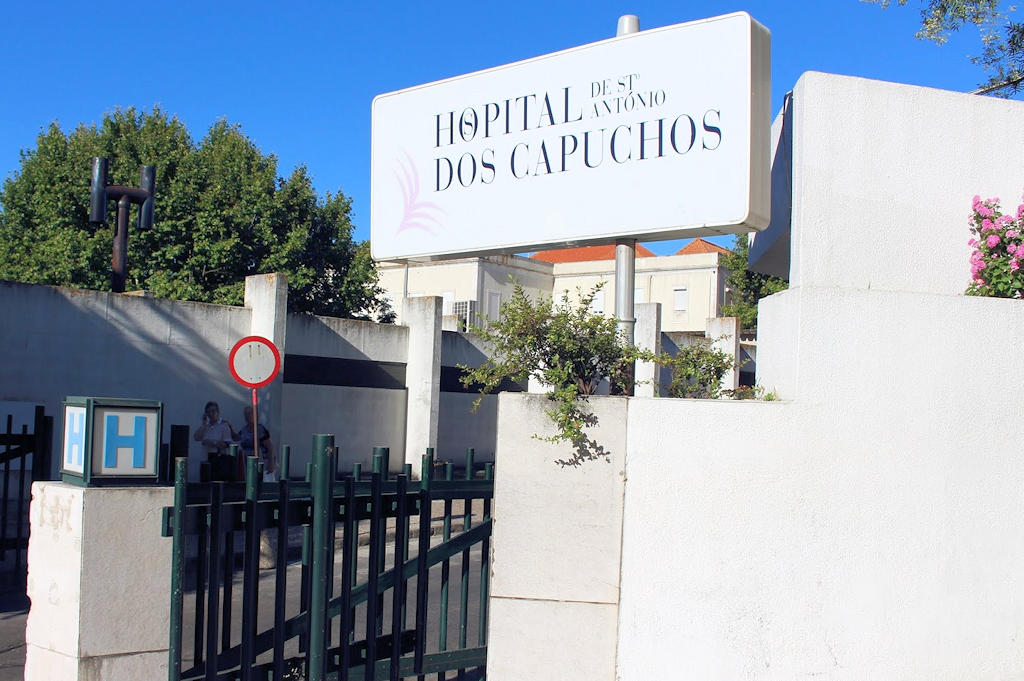In 1836, Queen Maria II of Portugal founded the Lisbon Mendicity Asylum within the hospital premises. The Asylum expanded through the construction of various pavilions and the acquisition, in 1854, of the Palace of the Counts of Murça or Mello, a 17th-century palace. Officially established as a hospital in 1928, the site housed nine clinical services at the time of its foundation. In 1930, the Artur Ravara Nursing School was inaugurated within the hospital, becoming the first public nursing school in Portugal.
Over the years, numerous adaptations were made to the buildings to accommodate the hospital's functions, including the modification of the cloisters in 1940, which resulted in the creation of various scattered buildings. Despite these changes, traces of its history can still be found within the hospital grounds.
At the entrance to the Hematology Department, known as the "Clock Courtyard", there is the mouth of the cistern from the former Convent of Saint Anthony of the Capuchins. This cistern, adorned with 17th-century tiles, was closed off in the late 19th century after an alleged suicide of one of the asylum's residents. Atop the cistern, the country's oldest sundial was placed, believed to date back to 1586. It was previously located near the convent's enclosure.
Since 1986, both the cistern and the sundial have been classified as public interest properties by the Institute for the Management of Architectural and Archaeological Heritage (IGESPAR). The former Church of the Capuchin Convent, along with all the rooms adorned with tile wainscoting, including the cloister (housing a bust of Tomás de Melo Breyner) and the noble staircase, are also classified as public interest properties.
The Church, which once served as the hospital's archive, has undergone partial restoration and regained its religious functions. The Palace of the Counts of Murça, which now houses the majority of the Surgery Department, remains unprotected by IGESPAR. This building, although heavily modified, retains a monumental staircase and a ballroom (currently the women's ward of the surgery department) with walls adorned with tile panels depicting palace scenes, war, and hunting.
In 1997, the Museum Nucleus of the Hospital of Saint Anthony of the Capuchins was created in the basement of the aforementioned palace. It houses an important scientific collection, including the earliest known wheelchair in Portugal, originating from Cardiff and dating back to the 17th century.
Lisbon.vip Recommends
Despite the gradual closure of some departments over the years, such as the Neurosurgery Department, which was the country's first and closed on September 30, 2011, Hospital de Santo António dos Capuchos still houses unique specialties within the CHLC, including Dermatology, Gastroenterology, Hematology, Neurology, and Oncology. These departments have been pioneers in their respective fields in Portugal.
In April 2017, after ten years of disuse, the former neurosurgery department of the Hospital de Santo António dos Capuchos reopened as the Museum of Health. It offers visitors the opportunity to revisit 800 years of medical history in Portugal through the study of 2,500 pieces. The exhibits include tiles from the Hospital of All Saints, which was destroyed in the earthquake, scientific instruments, furniture, and an 18th-century prescription.
Hospital de Santo António dos Capuchos stands as a testament to centuries of medical excellence, preserving its rich history while providing exceptional healthcare services to the people of Lisbon.
Map View



